Attached files
| file | filename |
|---|---|
| 8-K - 8-K - ASHFORD HOSPITALITY TRUST INC | ahtinvestorpresentation8-k.htm |

Company Presentation – November 2016
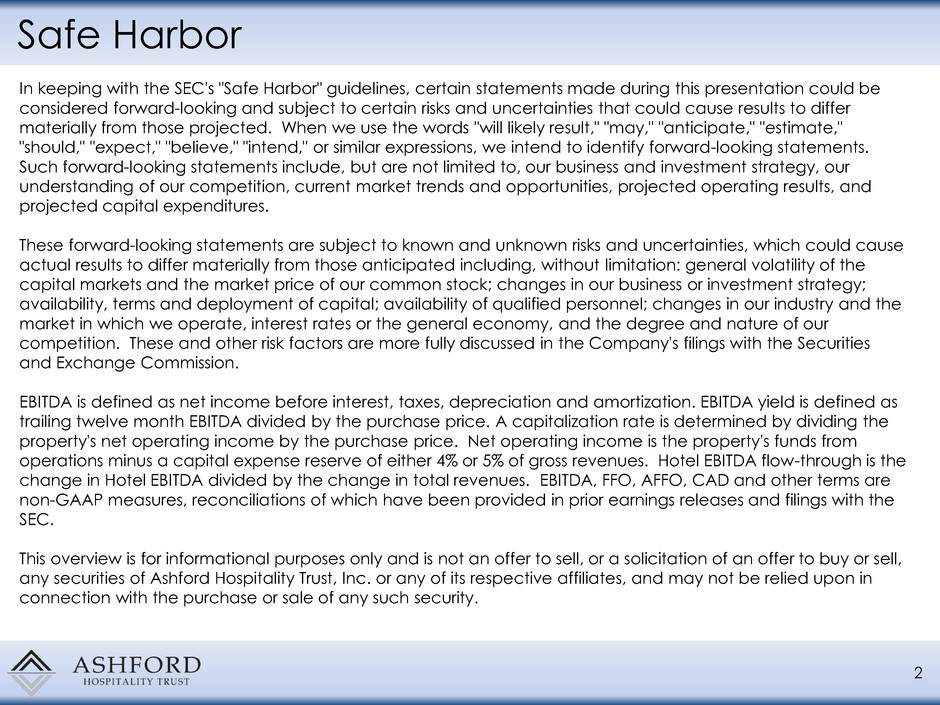
Safe Harbor
2
In keeping with the SEC's "Safe Harbor" guidelines, certain statements made during this presentation could be
considered forward-looking and subject to certain risks and uncertainties that could cause results to differ
materially from those projected. When we use the words "will likely result," "may," "anticipate," "estimate,"
"should," "expect," "believe," "intend," or similar expressions, we intend to identify forward-looking statements.
Such forward-looking statements include, but are not limited to, our business and investment strategy, our
understanding of our competition, current market trends and opportunities, projected operating results, and
projected capital expenditures.
These forward-looking statements are subject to known and unknown risks and uncertainties, which could cause
actual results to differ materially from those anticipated including, without limitation: general volatility of the
capital markets and the market price of our common stock; changes in our business or investment strategy;
availability, terms and deployment of capital; availability of qualified personnel; changes in our industry and the
market in which we operate, interest rates or the general economy, and the degree and nature of our
competition. These and other risk factors are more fully discussed in the Company's filings with the Securities
and Exchange Commission.
EBITDA is defined as net income before interest, taxes, depreciation and amortization. EBITDA yield is defined as
trailing twelve month EBITDA divided by the purchase price. A capitalization rate is determined by dividing the
property's net operating income by the purchase price. Net operating income is the property's funds from
operations minus a capital expense reserve of either 4% or 5% of gross revenues. Hotel EBITDA flow-through is the
change in Hotel EBITDA divided by the change in total revenues. EBITDA, FFO, AFFO, CAD and other terms are
non-GAAP measures, reconciliations of which have been provided in prior earnings releases and filings with the
SEC.
This overview is for informational purposes only and is not an offer to sell, or a solicitation of an offer to buy or sell,
any securities of Ashford Hospitality Trust, Inc. or any of its respective affiliates, and may not be relied upon in
connection with the purchase or sale of any such security.

Ashford Hospitality Trust
Opportunistic platform focused on upper-upscale, full-service hotels
3
Attractive dividend yield
Targets moderate debt levels of 55-60% net debt/gross assets
Targets cash level of 25-35% of total equity market cap
Superior long-term total shareholder return performance
Highly-aligned management team & advisory structure
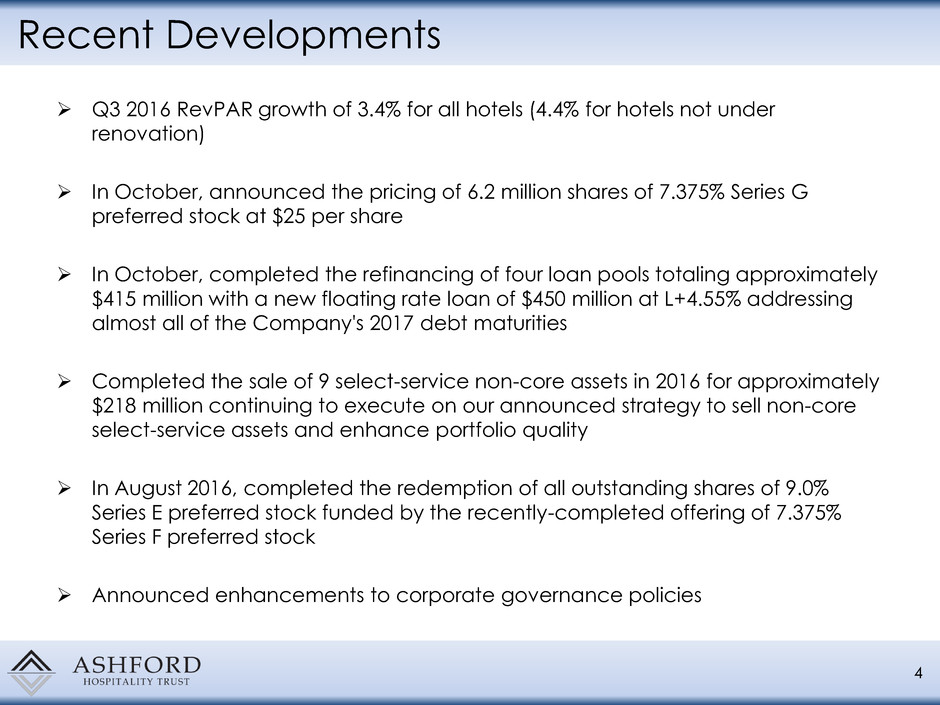
Recent Developments
4
Q3 2016 RevPAR growth of 3.4% for all hotels (4.4% for hotels not under
renovation)
In October, announced the pricing of 6.2 million shares of 7.375% Series G
preferred stock at $25 per share
In October, completed the refinancing of four loan pools totaling approximately
$415 million with a new floating rate loan of $450 million at L+4.55% addressing
almost all of the Company's 2017 debt maturities
Completed the sale of 9 select-service non-core assets in 2016 for approximately
$218 million continuing to execute on our announced strategy to sell non-core
select-service assets and enhance portfolio quality
In August 2016, completed the redemption of all outstanding shares of 9.0%
Series E preferred stock funded by the recently-completed offering of 7.375%
Series F preferred stock
Announced enhancements to corporate governance policies
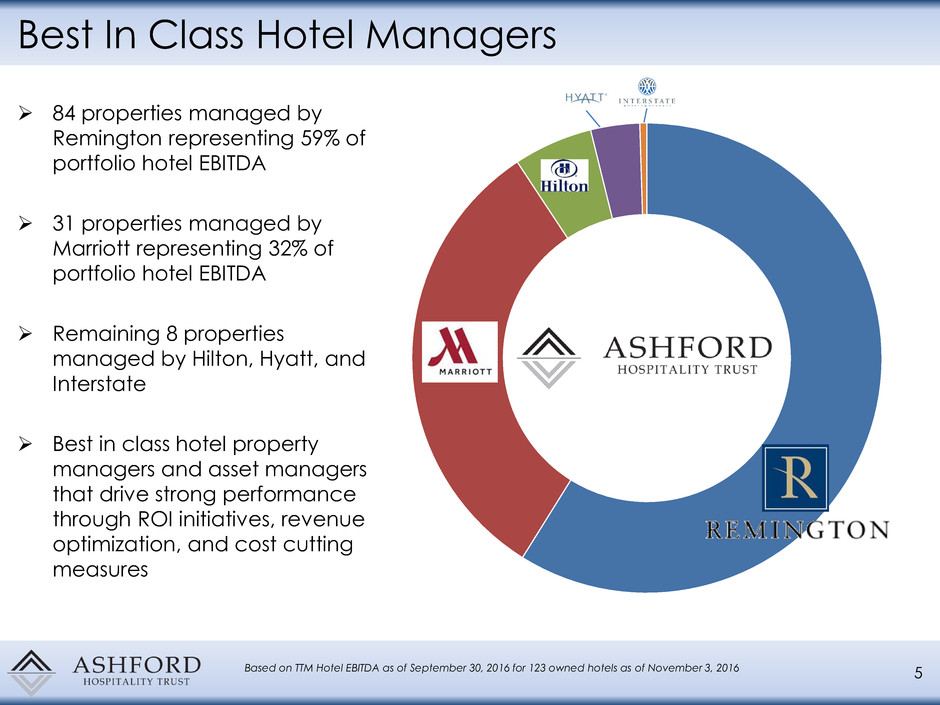
Best In Class Hotel Managers
84 properties managed by
Remington representing 59% of
portfolio hotel EBITDA
31 properties managed by
Marriott representing 32% of
portfolio hotel EBITDA
Remaining 8 properties
managed by Hilton, Hyatt, and
Interstate
Best in class hotel property
managers and asset managers
that drive strong performance
through ROI initiatives, revenue
optimization, and cost cutting
measures
5 Based on TTM Hotel EBITDA as of September 30, 2016 for 123 owned hotels as of November 3, 2016

52%
58% 59%
43% 41% 42%
22%
53%
60% 59%
68% 70%
47%
57%
-200%
-175%
-150%
-125%
-100%
-75%
-50%
-25%
0%
25%
50%
75%
100%
2008 2009 2010 2011 2012 2013 2014 2015
Non-Remington Remington
Remington Outperformance - Profitability
Remington has outperformed in EBITDA flow-through 7 out of the
last 8 years
6 NOTE: Remington managed hotels owned by Ashford Trust and Ashford Prime as compared to Non-Remington managed hotels
Hotel EBITDA Flow-Through
Superior management of downside risk and cash flow loss
300
-800 -808%
334%

67%
-29% -28%
100% 91%
15%
59%
36%
-2%
-26% -18%
111%
30%
73%
401%
237%
20%
42% 39%
-12%
-37%
-14%
-100%
-50%
0%
50%
100%
150%
200%
250%
300%
350%
400%
450%
Inception 10-Yr 9-Yr 8-Yr 7-Yr 6-Yr 5-Yr 4-Yr 3-Yr 2-Yr 1-Yr
Peer Avg AHT
Demonstrated Long-Term Track Record
7
(1) Since IPO on August 26, 2003
Peer average includes: CHSP, CLDT, DRH, FCH, HST, HT, INN, LHO, RLJ, SHO
Returns as of 11/3/16
Source: SNL
Total Shareholder Return
Long-term
performance
significantly
outperforms peers
(1)
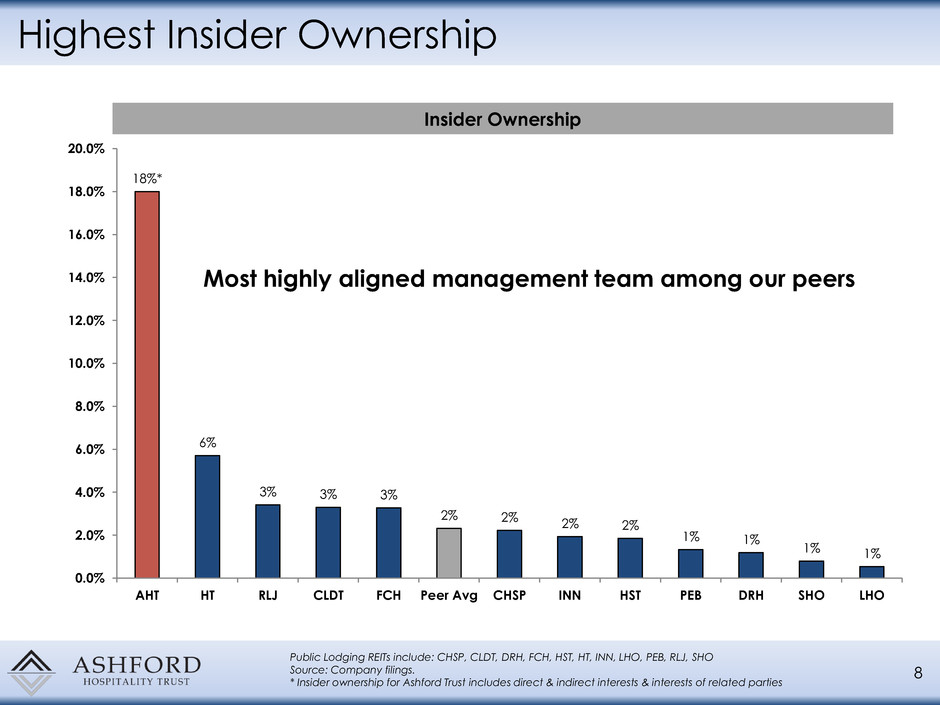
Highest Insider Ownership
8
Public Lodging REITs include: CHSP, CLDT, DRH, FCH, HST, HT, INN, LHO, PEB, RLJ, SHO
Source: Company filings.
* Insider ownership for Ashford Trust includes direct & indirect interests & interests of related parties
Insider Ownership
Most highly aligned management team among our peers
18%*
6%
3% 3% 3%
2% 2% 2% 2%
1% 1%
1% 1%
0.0%
2.0%
4.0%
6.0%
8.0%
10.0%
12.0%
14.0%
16.0%
18.0%
20.0%
AHT HT RLJ CLDT FCH Peer Avg CHSP INN HST PEB DRH SHO LHO
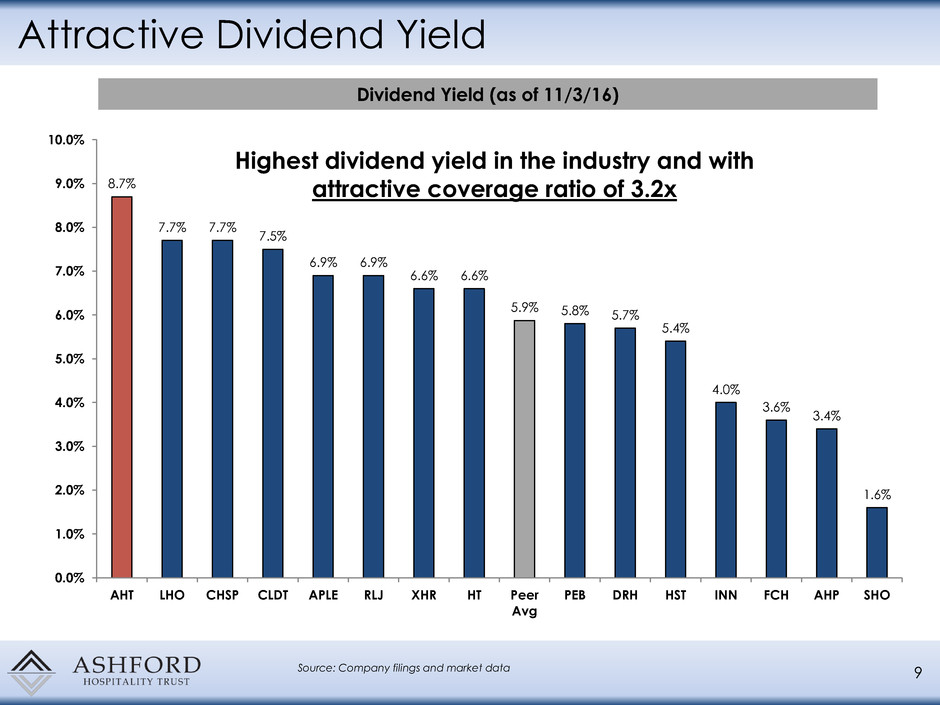
Attractive Dividend Yield
9 Source: Company filings and market data
Dividend Yield (as of 11/3/16)
Highest dividend yield in the industry and with
attractive coverage ratio of 3.2x
8.7%
7.7% 7.7%
7.5%
6.9% 6.9%
6.6% 6.6%
5.9% 5.8% 5.7%
5.4%
4.0%
3.6%
3.4%
1.6%
0.0%
1.0%
2.0%
3.0%
4.0%
5.0%
6.0%
7.0%
8.0%
9.0%
10.0%
AHT LHO CHSP CLDT APLE RLJ XHR HT Peer
Avg
PEB DRH HST INN FCH AHP SHO
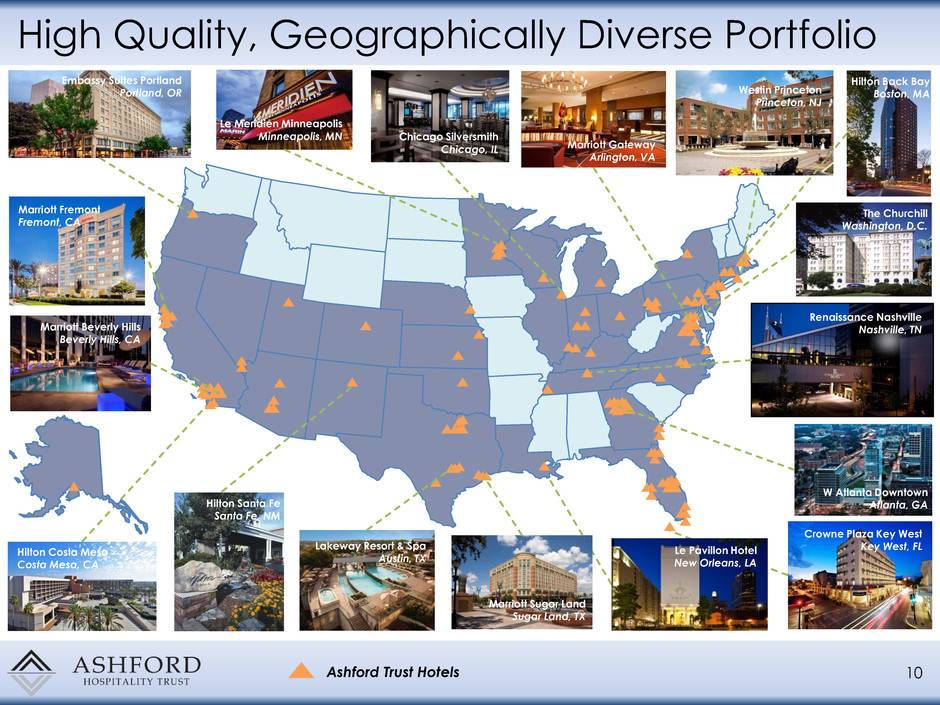
10 Ashford Trust Hotels
High Quality, Geographically Diverse Portfolio
Le Pavillon Hotel
New Orleans, LA
Lakeway Resort & Spa
Austin, TX
Hilton Costa Mesa
Costa Mesa, CA
Marriott Fremont
Fremont, CA
Le Meridien Minneapolis
Minneapolis, MN Chicago Silversmith
Chicago, IL
Hilton Back Bay
Boston, MA
The Churchill
Washington, D.C.
W Atlanta Downtown
Atlanta, GA
Crowne Plaza Key West
Key West, FL
Marriott Sugar Land
Sugar Land, TX
Hilton Santa Fe
Santa Fe, NM
Renaissance Nashville
Nashville, TN
Westin Princeton
Princeton, NJ
Marriott Beverly Hills
Beverly Hills, CA
Embassy Suites Portland
Portland, OR
Marriott Gateway
Arlington, VA
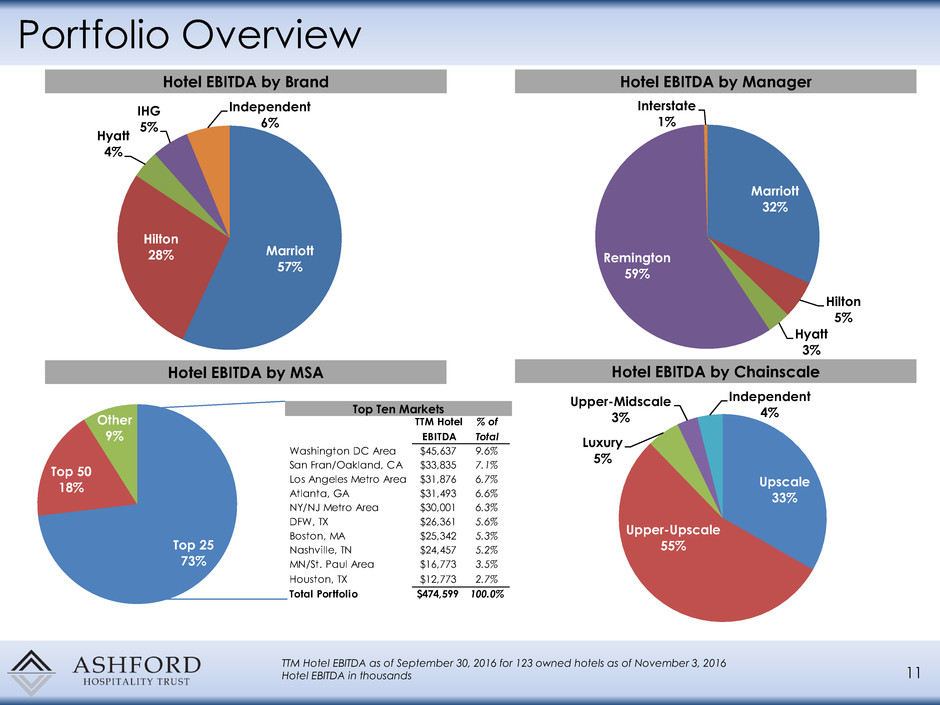
Top 25
73%
Top 50
18%
Other
9%
Portfolio Overview
11
TTM Hotel EBITDA as of September 30, 2016 for 123 owned hotels as of November 3, 2016
Hotel EBITDA in thousands
Hotel EBITDA by Brand Hotel EBITDA by Manager
Hotel EBITDA by MSA Hotel EBITDA by Chainscale
Top Ten Markets
Marriott
57%
Hilton
28%
Hyatt
4%
IHG
5%
Independent
6%
Marriott
32%
Hilton
5%
Hyatt
3%
Remington
59%
Interstate
1%
Upscale
33%
Upper-Upscale
55%
Luxury
5%
Upper-Midscale
3%
Independent
4%
TTM Hotel % of
EBITDA Total
Washington DC Area $45,637 9.6%
San Fran/Oakland, CA $33,835 7.1%
Los Angeles Metro Area $31,876 6.7%
Atlanta, GA $31,493 6.6%
NY/NJ Metro Area $30,001 6.3%
DFW, X $26,361 5.6%
Boston, MA $25,342 5.3%
Nashville, TN $24,457 5.2%
MN/St. Paul Area $16,773 3.5%
Houston, TX $12,773 2.7%
Total Portfolio $474,599 100.0%
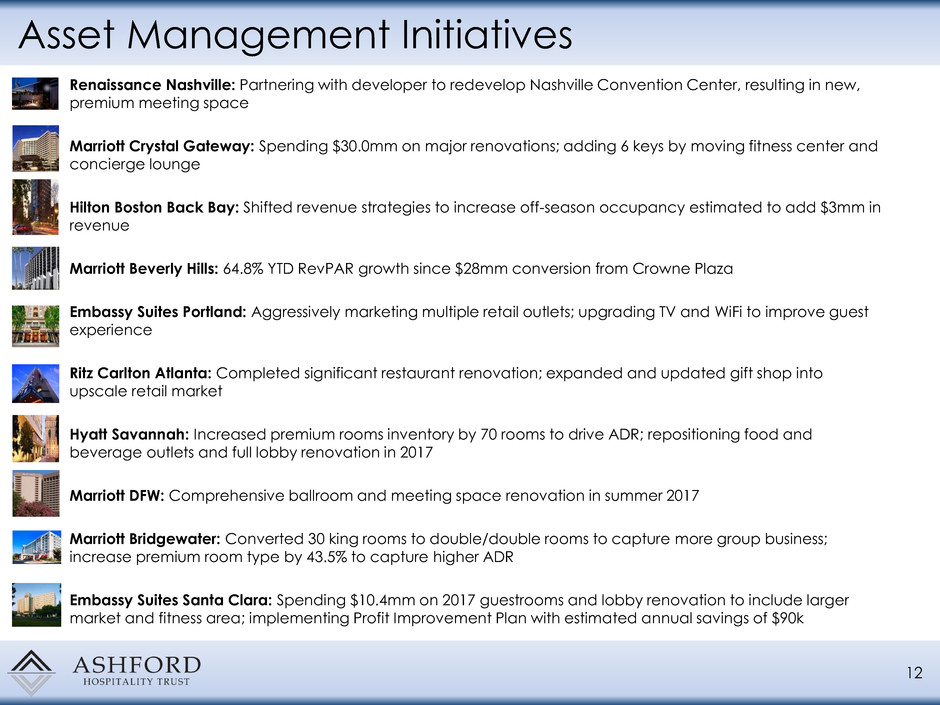
Renaissance Nashville: Partnering with developer to redevelop Nashville Convention Center, resulting in new,
premium meeting space
Marriott Crystal Gateway: Spending $30.0mm on major renovations; adding 6 keys by moving fitness center and
concierge lounge
Hilton Boston Back Bay: Shifted revenue strategies to increase off-season occupancy estimated to add $3mm in
revenue
Marriott Beverly Hills: 64.8% YTD RevPAR growth since $28mm conversion from Crowne Plaza
Embassy Suites Portland: Aggressively marketing multiple retail outlets; upgrading TV and WiFi to improve guest
experience
Ritz Carlton Atlanta: Completed significant restaurant renovation; expanded and updated gift shop into
upscale retail market
Hyatt Savannah: Increased premium rooms inventory by 70 rooms to drive ADR; repositioning food and
beverage outlets and full lobby renovation in 2017
Marriott DFW: Comprehensive ballroom and meeting space renovation in summer 2017
Marriott Bridgewater: Converted 30 king rooms to double/double rooms to capture more group business;
increase premium room type by 43.5% to capture higher ADR
Embassy Suites Santa Clara: Spending $10.4mm on 2017 guestrooms and lobby renovation to include larger
market and fitness area; implementing Profit Improvement Plan with estimated annual savings of $90k
12
Asset Management Initiatives
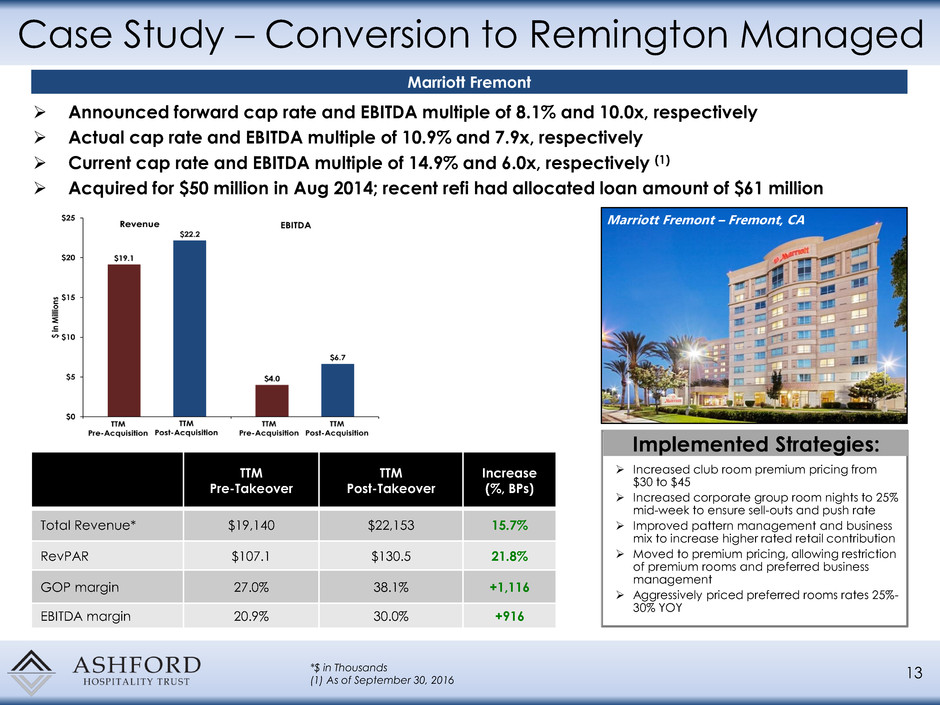
Case Study – Conversion to Remington Managed
13
Implemented Strategies:
Increased club room premium pricing from
$30 to $45
Increased corporate group room nights to 25%
mid-week to ensure sell-outs and push rate
Improved pattern management and business
mix to increase higher rated retail contribution
Moved to premium pricing, allowing restriction
of premium rooms and preferred business
management
Aggressively priced preferred rooms rates 25%-
30% YOY
Marriott Fremont – Fremont, CA
*$ in Thousands
(1) As of September 30, 2016
Announced forward cap rate and EBITDA multiple of 8.1% and 10.0x, respectively
Actual cap rate and EBITDA multiple of 10.9% and 7.9x, respectively
Current cap rate and EBITDA multiple of 14.9% and 6.0x, respectively (1)
Acquired for $50 million in Aug 2014; recent refi had allocated loan amount of $61 million
TTM
Pre-Takeover
TTM
Post-Takeover
Increase
(%, BPs)
Total Revenue* $19,140 $22,153 15.7%
RevPAR $107.1 $130.5 21.8%
GOP margin 27.0% 38.1% +1,116
EBITDA margin 20.9% 30.0% +916
Marriott Fremont
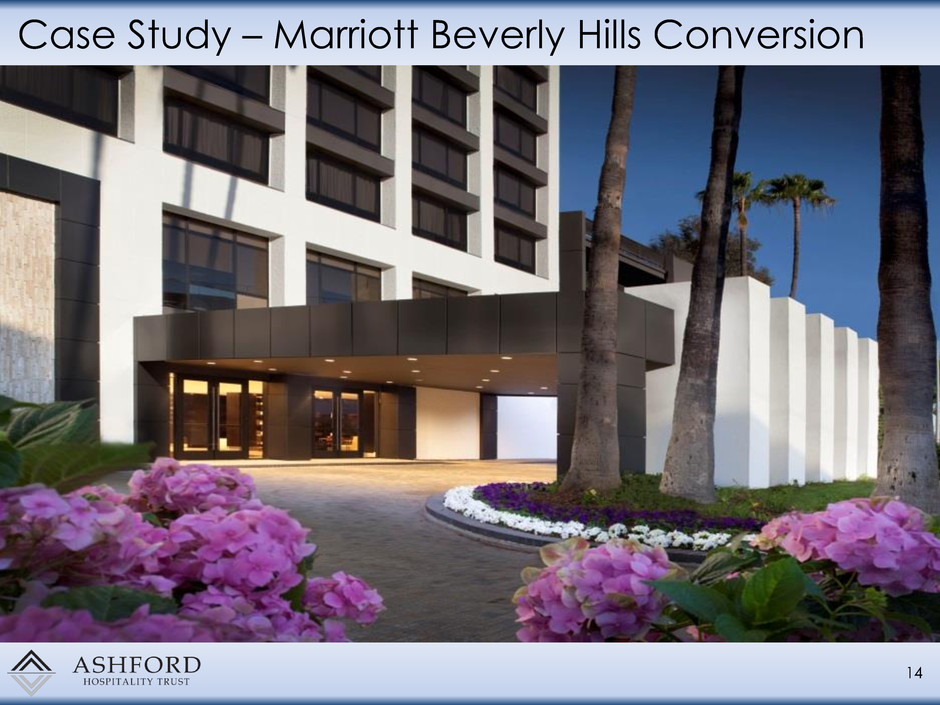
Case Study – Marriott Beverly Hills Conversion
14
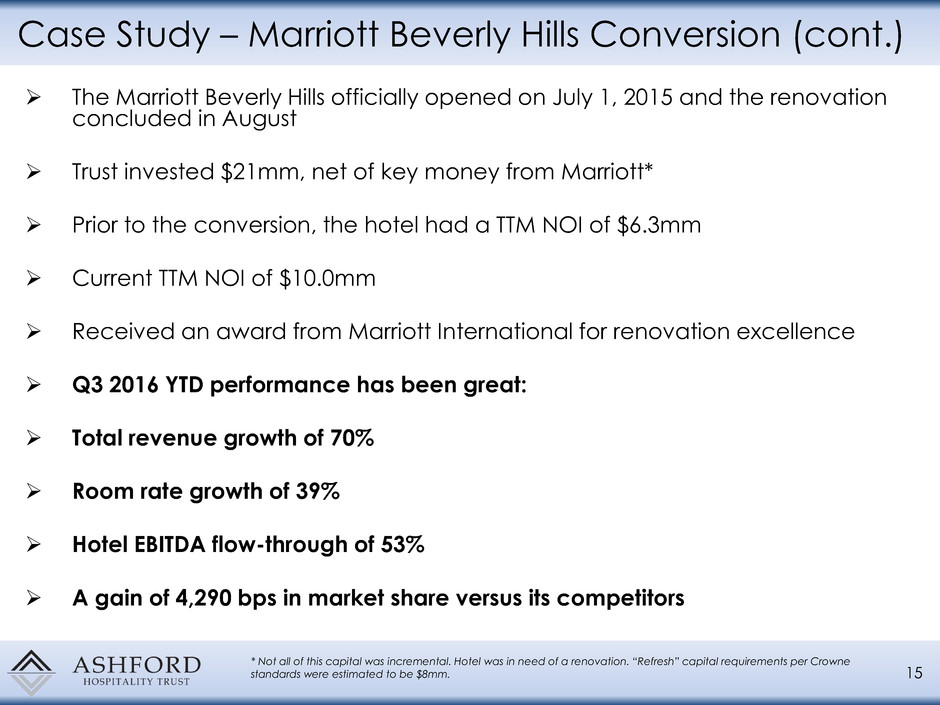
15
Case Study – Marriott Beverly Hills Conversion (cont.)
The Marriott Beverly Hills officially opened on July 1, 2015 and the renovation
concluded in August
Trust invested $21mm, net of key money from Marriott*
Prior to the conversion, the hotel had a TTM NOI of $6.3mm
Current TTM NOI of $10.0mm
Received an award from Marriott International for renovation excellence
Q3 2016 YTD performance has been great:
Total revenue growth of 70%
Room rate growth of 39%
Hotel EBITDA flow-through of 53%
A gain of 4,290 bps in market share versus its competitors
* Not all of this capital was incremental. Hotel was in need of a renovation. “Refresh” capital requirements per Crowne
standards were estimated to be $8mm.
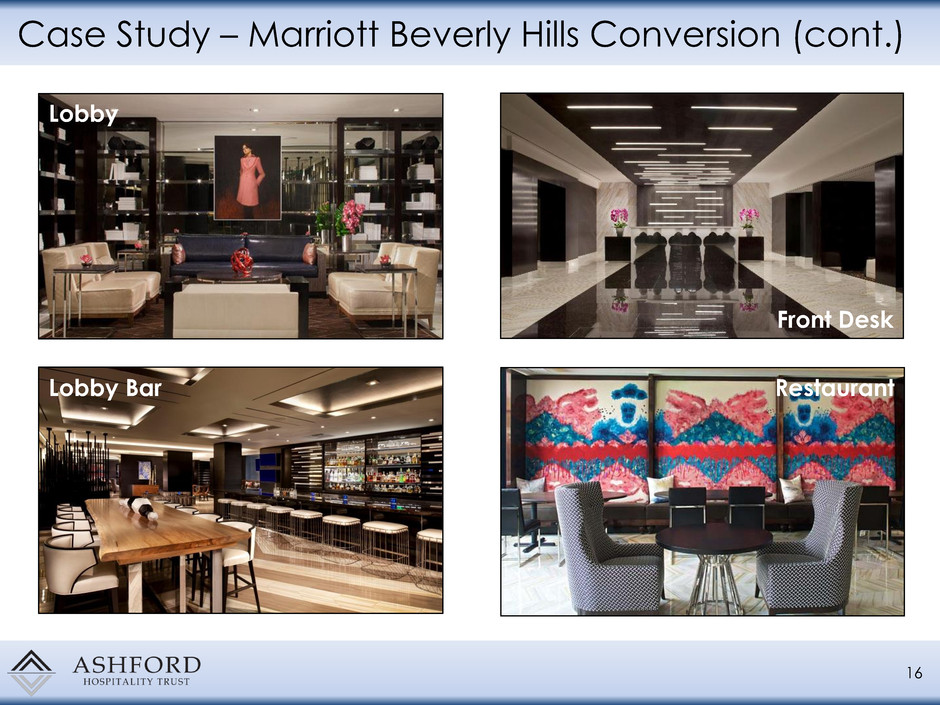
16
Case Study – Marriott Beverly Hills Conversion (cont.)
Lobby Bar Restaurant
Front Desk
Lobby
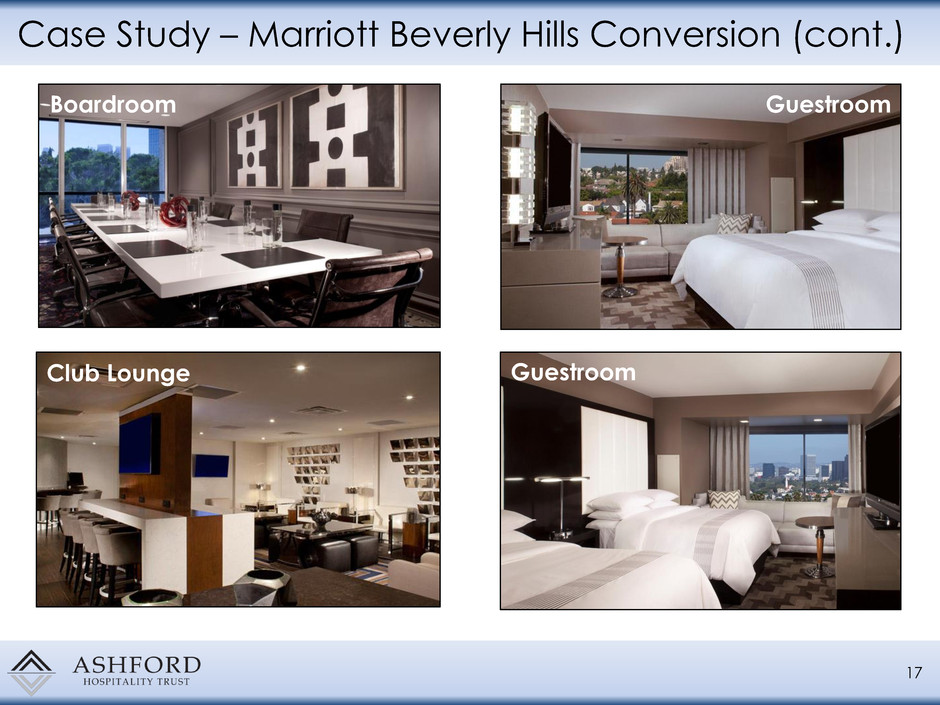
17
Case Study – Marriott Beverly Hills Conversion (cont.)
Guestroom
Boardroom Guestroom
Club Lounge
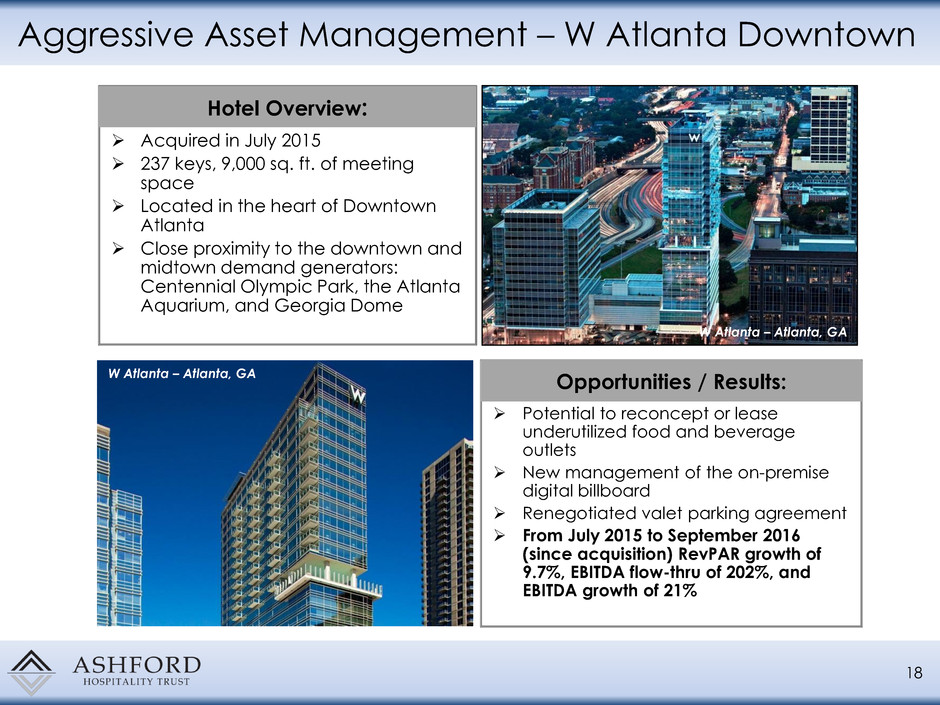
Aggressive Asset Management – W Atlanta Downtown
18
Acquired in July 2015
237 keys, 9,000 sq. ft. of meeting
space
Located in the heart of Downtown
Atlanta
Close proximity to the downtown and
midtown demand generators:
Centennial Olympic Park, the Atlanta
Aquarium, and Georgia Dome
Potential to reconcept or lease
underutilized food and beverage
outlets
New management of the on-premise
digital billboard
Renegotiated valet parking agreement
From July 2015 to September 2016
(since acquisition) RevPAR growth of
9.7%, EBITDA flow-thru of 202%, and
EBITDA growth of 21%
W Atlanta – Atlanta, GA
W Atlanta – Atlanta, GA
Hotel Overview:
Opportunities / Results:
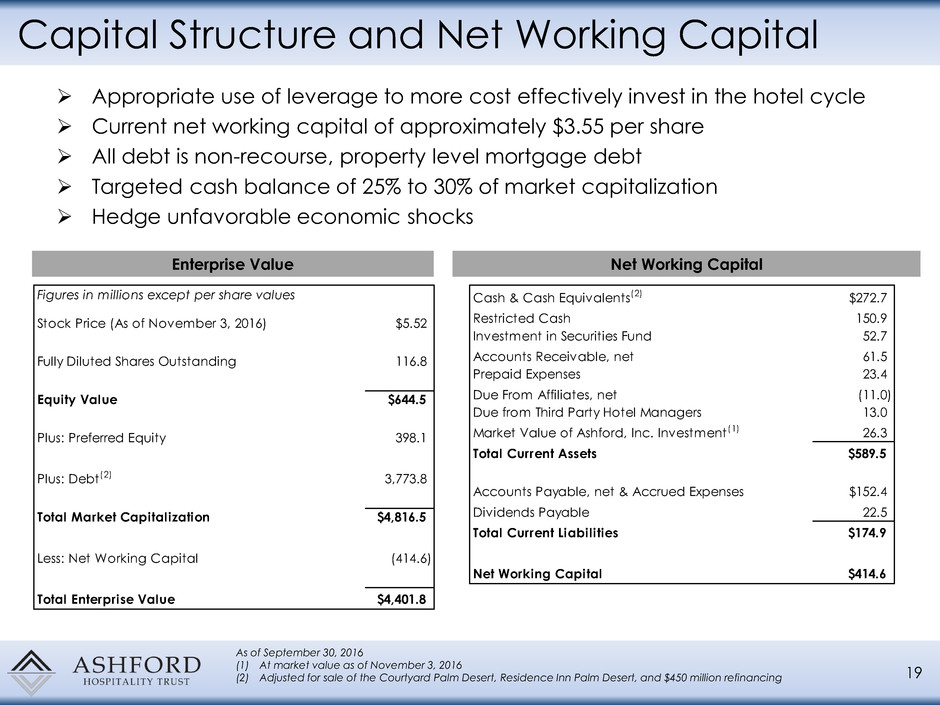
Capital Structure and Net Working Capital
Appropriate use of leverage to more cost effectively invest in the hotel cycle
Current net working capital of approximately $3.55 per share
All debt is non-recourse, property level mortgage debt
Targeted cash balance of 25% to 30% of market capitalization
Hedge unfavorable economic shocks
19
As of September 30, 2016
(1) At market value as of November 3, 2016
(2) Adjusted for sale of the Courtyard Palm Desert, Residence Inn Palm Desert, and $450 million refinancing
Enterprise Value Net Working Capital
Figures in millions except per share values
Stock Price (As of November 3, 2016) $5.52
Fully Diluted Shares Outstanding 116.8
Equity Value $644.5
Plus: Preferred Equity 398.1
Plus: Debt(2) 3,773.8
Total Market Capitalization $4,816.5
Less: Net Working Capital (414.6)
Total Enterprise Value $4,401.8
Cash & Cash Equivalents(2) $272.7
Restricted Cash 150.9
Investment in Securities Fund 52.7
Accounts Receivable, net 61.5
Prepaid Expenses 23.4
Due From Affiliates, net (11.0)
Due from Third Party Hotel Managers 13.0
Market Value of Ashford, Inc. Investment(1) 26.3
Total Current Assets $589.5
Accounts Payable, net & Accrued Expenses $152.4
Dividends Payable 22.5
Total Current Liabilities $174.9
Net Working Capital $414.6
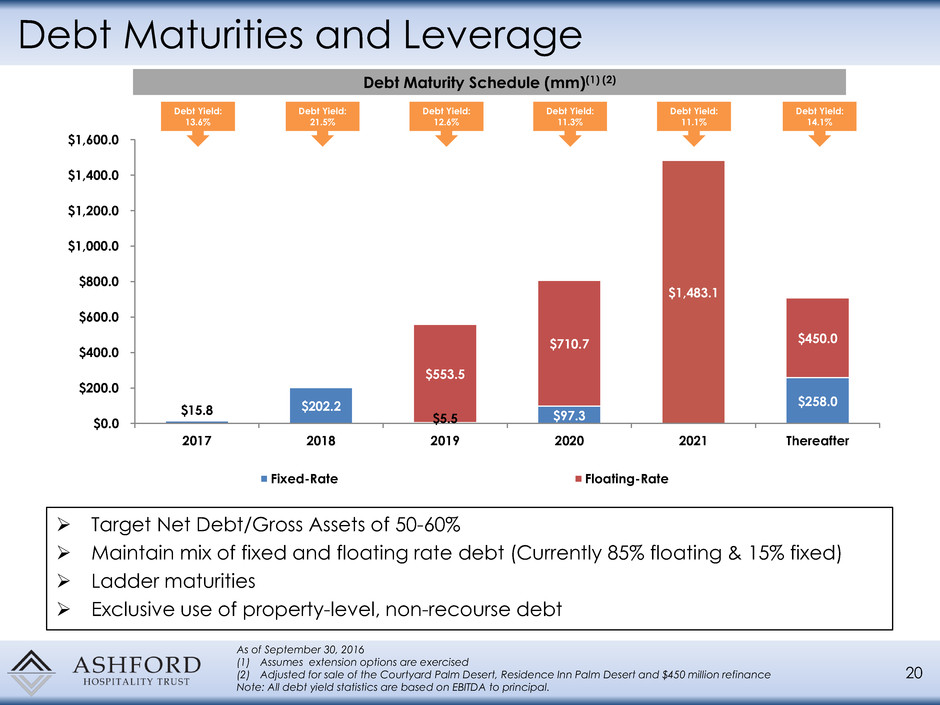
$15.8 $202.2
$5.5 $97.3
$258.0
$553.5
$710.7
$1,483.1
$450.0
$0.0
$200.0
$400.0
$600.0
$800.0
$1,000.0
$1,200.0
$1,400.0
$1,600.0
2017 2018 2019 2020 2021 Thereafter
Fixed-Rate Floating-Rate
Debt Maturities and Leverage
Target Net Debt/Gross Assets of 50-60%
Maintain mix of fixed and floating rate debt (Currently 85% floating & 15% fixed)
Ladder maturities
Exclusive use of property-level, non-recourse debt
20
As of September 30, 2016
(1) Assumes extension options are exercised
(2) Adjusted for sale of the Courtyard Palm Desert, Residence Inn Palm Desert and $450 million refinance
Note: All debt yield statistics are based on EBITDA to principal.
Debt Maturity Schedule (mm)(1) (2)
Debt Yield:
14.1%
Debt Yield:
12.6%
Debt Yield:
21.5%
Debt Yield:
13.6%
Debt Yield:
11.3%
Debt Yield:
11.1%

Corporate Governance Enhancements
21
Modification of the Company’s Equity Incentive Plan to
require stock ownership by directors and officers to match
the stock ownership guidelines outlined in the current
Corporate Governance Guidelines
Modification of the Company’s Equity Incentive Plan to
require minimum vesting periods on stock options and stock
appreciation rights issued under the plan
Modification of the Company’s By-laws to reduce the
threshold from 35% to 30% of outstanding shares to call a
special meeting of shareholders.
Modification of the Company’s stock ownership guidelines
to increase the required share ownership for director’s from
three times the director’s annual board retainer fee to four
times

Board of Directors Diversity Matrix
Professional Experience Geography Independence
Real Estate /
Hospitality
C-Suite
Executive
Entrepreneurship Legal Southwest
West
Coast
Northeast Southeast Independent
Monty J.
Bennett
Benjamin J.
Ansell, M.D.
Fred Kleisner
Amish Gupta
Kamal Jafarnia
Philip S. Payne
Alan L. Tallis
22
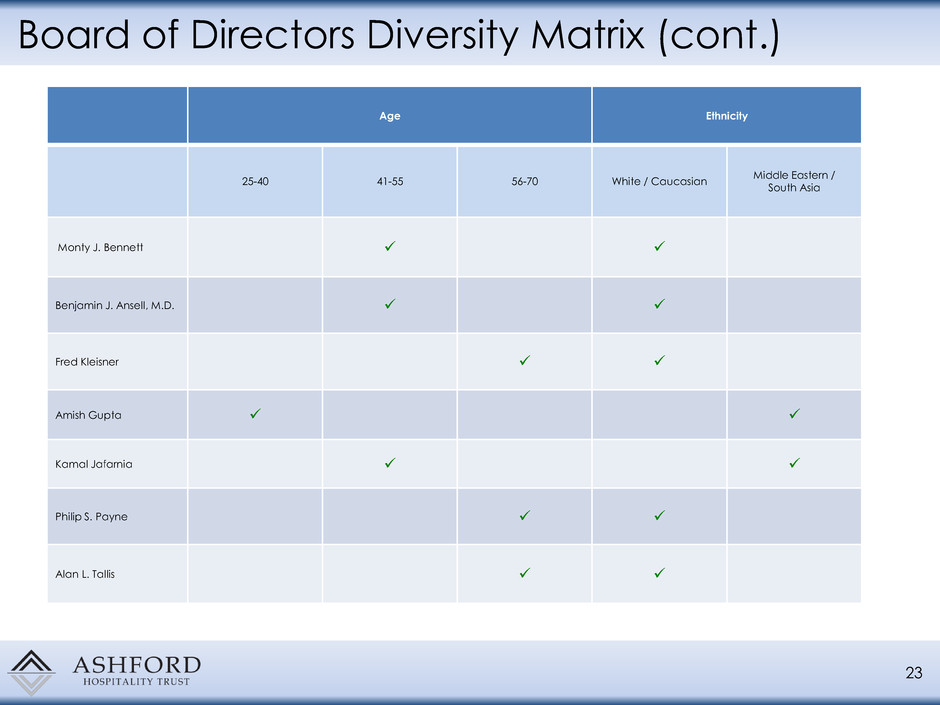
Board of Directors Diversity Matrix (cont.)
Age Ethnicity
25-40 41-55 56-70 White / Caucasian
Middle Eastern /
South Asia
Monty J. Bennett
Benjamin J. Ansell, M.D.
Fred Kleisner
Amish Gupta
Kamal Jafarnia
Philip S. Payne
Alan L. Tallis
23
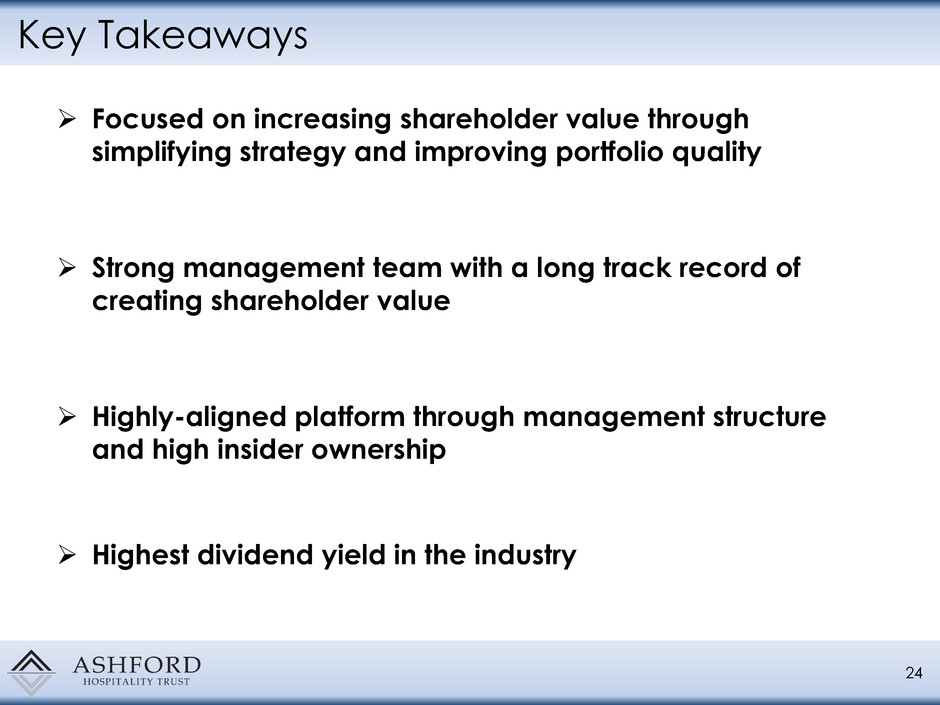
Key Takeaways
24
Focused on increasing shareholder value through
simplifying strategy and improving portfolio quality
Strong management team with a long track record of
creating shareholder value
Highest dividend yield in the industry
Highly-aligned platform through management structure
and high insider ownership

Company Presentation – November 2016
